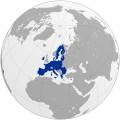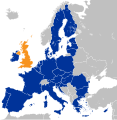User:Kolja21
| Kolja21 | ||||||||
|---|---|---|---|---|---|---|---|---|
| ||||||||
| Languages | ||||||||
| ||||||||
| Location | ||||||||
|



European Union[edit]
EU 27[edit]
3 March 2022[edit]
After Ukraine, Georgia and Moldova have also formally applied for membership
- Main maps
-
States with applications
28 February 2022[edit]
Ukrainian President Zelensky submits application for his country's admission to the EU
1 February 2020[edit]
- Main maps
-
Map of the European Union
-
EU as a single entity
-
EU on a globe
-
EU members and candidate countries
-
Candidate and potential candidate countries
-
EC-EU enlargement (animated)
-
Eastern Partnership (EaP)
-
EFTA countries
-
EFTA countries and former members
-
EU (transition period) and EFTA
-
EU, EFTA and EaP
-
Permanent Structured Cooperation (PESCO)
-
EU membership possible map
-
Supranational European Bodies
- Eurozone
-
Map of the Eurozone
-
Economic and Monetary Union (EMU)
-
EMU with states using the euro unilaterally
EU 28[edit]
31 January 2020[edit]
Brexit day
- Main maps (update needed)
-
States with applications (map without borders)
-
European Economic Area (EEA)
-
EU Customs Union (EUCU)
-
Free-trade area: EEA and EUCU
-
European Space Agency (ESA)
- Derivatived maps (unused)
-
EC-EU enlargement (animated png)
-
Further enlargement
(Polish version) -
EC-EU enlargement (colorful version with "animated legend")
29 March 2019[edit]
Brexit: deadline extended to 12 April; extended to 31 October; extended to 31 January 2020
29 March 2017[edit]
UK government invokes Article 50 of the Treaty on European Union (the formal procedure for withdrawing)
-
Location of the United Kingdom in the European Union
-
Location of the United Kingdom in Europe
23 June 2016[edit]
United Kingdom European Union membership referendum
-
President of the European Council
Donald Tusk -
Prime Minister of the United Kingdom
David Cameron -
Mayor of London
Boris Johnson -
Results by local voting areas (leave: 51.89%)
7 April 2016[edit]
Dutch Ukraine–European Union Association Agreement referendum
-
EU, Ukraine and the Russian-occupied territory
-
Result: 61.00% against
15 February 2016[edit]
Bosnia and Herzegovina applied for membership of the EU.
- Maps with the timestamp "EU28"
-
Candidate countries
-
Candidate and potential candidate countries
-
States with applications
5 July 2015[edit]
As a result of the referendum, the bailout conditions were rejected by a majority of over 61% to 39% approving.
The "No" vote (OXI in Greek) has won in all the regions of Greece.
12 March 2015[edit]
Iceland withdraws the application for membership
1 January 2015[edit]
Lithuania adopts the euro („Euras“).
18 September 2014[edit]
1st Scottish independence referendum
28 June 2014[edit]
The European Council accepts Serbia's application.
- no historical maps (maps have been updated)
Late February 2014[edit]
Russian special forces and pro-Russian militias occupy the Autonomous Republic of Crimea, Ukraine.
-
Political map of Ukraine, highlighting Crimean Oblast
-
Eastern Partnership (with timestamp 2013)
1 January 2014[edit]
Latvia adopts the euro („Eiro“).
- Maps with timestamp
-
Map of the Eurozone (2014)
-
Economic and Monetary Union (EMU 2014)
-
duplicate tif file (not used any more)
1 July 2013[edit]
Croatia becomes the 28th member of the European Union.
- Maps with timestamp
-
Map of the EU 28
-
EU 27+1
-
EU 28 as a single entity
-
EU 28 as a single entity (world)
-
EU 28 on a globe
-
Eastern Partnership
-
EFTA and Eastern Partnership
-
Map of the Eurozone (2013)
-
Economic and Monetary Union (EMU)
-
Further enlargement
(“EU 45”) -
Union for the Mediterranean
See also: fr:Projet:Union européenne/Entrée de la Croatie
EU 27[edit]
2 March 2012[edit]
The European Council accepts Serbia's application.
-
EU 27 Candidate countries
-
EU 27 Candidate and potential candidate countries
-
EU 27, EFTA and Eastern Partnership
-
Further enlargement (“EU 45”)
-
States with applications
-
States with applications (world)
30 January 2012[edit]
European Fiscal Compact: The draft intergovernmental treaty is finalised. (The treaty was signed on 2 March.)
-
EU fiscal treaty (2012)
1 January 2011[edit]
-
Map of the Eurozone (2011)
-
Economic and Monetary Union
17 December 2010[edit]
The European Council accepts Montenegro's application.
-
EFTA and Eastern Partnership (2010)
22 December 2009[edit]
Serbia officially applied for membership.
-
Serbia and EU
17 July 2009[edit]
Iceland officially applied for membership.
-
Iceland and EU
7 May 2009[edit]
Founding summit of the Eastern Partnership in Prague.
-
Eastern Partnership
-
EFTA and Eastern Partnership (2009)
28 April 2009[edit]
Albania officially applied for membership.
-
Albania and EU
1 January 2009[edit]
-
Map of the Eurozone (2009)
-
Economic and Monetary Union
15 December 2008[edit]
Montenegro officially applied for membership.
-
Montenegro and EU
13 July 2008[edit]
Founding summit of the Union for the Mediterranean in Paris.
-
Union for the Mediterranean
17 February 2008[edit]
The Assembly of Kosovo declared Kosovo's independence.
-
Map of the EU 27
-
EU 27 as a single entity
-
EU 27 as a single entity (world)
-
EU 27 on a globe
11 May 2007[edit]
The Republic of Montenegro joined the Council of Europe as its 47th member.
-
Council of Europe
-
Founder map
-
Plaque: first session Strasbourg 1949
1 January 2007[edit]
Romania and Bulgaria became the EU's newest members (Treaty of Accession 2005).
-
Map of the EU 27
-
EU 27 as a single entity
-
EU 27 as a single entity (world)
-
EU 27 on a globe
-
EU 25+2
-
EU 27 map incorporating flag
EU 25[edit]
May and June 2005[edit]
French (29 May) and Dutch (1 June) Referendum on the Treaty establishing a Constitution for Europe.
1 May 2004[edit]
The 2004 enlargement of the European Union with ten new members was the largest single expansion in the EU history. The simultaneous accessions concerned the following countries: Cyprus, Czech Republic, Estonia, Hungary, Latvia, Lithuania, Malta, Poland, Slovakia and Slovenia. Seven of these were members of the former eastern bloc, with one from the former Yugoslavia (Slovenia) and the remaining two being Mediterranean islands (Malta and Cyprus).
-
Map of the EU 25
-
EU 15+10
EU 15[edit]
1 January 1999[edit]
The euro was introduced to world financial markets as an accounting currency, replacing the former European Currency Unit (ECU) at a ratio of 1:1. Euro coins and banknotes entered circulation on 1 January 2002.
-
Map of the Eurozone (1999/2002)
-
Economic and Monetary Union (EMU) (TO DO)
1 January 1996[edit]
Turkey becomes part of the European Union Customs Union (EUCU).
-
The EUCU (today; no historic map available)
1 January 1995[edit]
Austria, Sweden and Finland left the EFTA and acceded to the EU marking its fourth enlargement. (The Norwegian government lost a second national referendum on membership.)
-
Map of the EU 15 (1995)
-
EU 12+3
-
EFTA countries (1995)
EU 12[edit]
1 November 1993[edit]
The Maastricht Treaty entered into force.
-
Map of the EU 12 (1992/93)
7 February 1992[edit]
The Maastricht Treaty (formally, the Treaty on European Union) was signed in Maastricht, the Netherlands after final negotiations on 9 December 1991 between the members of the European Community. It created the European Union and led to the establishing of the euro.
European Community[edit]
EC 12[edit]
3 October 1990[edit]
German reunification. The five re-established states of the German Democratic Republic (East Germany) joined the Federal Republic of Germany (West Germany), and Berlin was united into a single city-state.
-
Map of the EC 12 (1990)
-
EC 12, inc. Ex-GDR
9 November 1989[edit]
East German government announced on 9 November 1989, after several weeks of civil unrest, that all GDR citizens could visit West Germany and West Berlin. The fall of the Berlin Wall paved the way for German reunification, which was formally concluded on 3 October 1990.
1 Januar 1986[edit]
Spain and Portugal enter the European Community. (1985 Greenland left the EC but remains associated with it as overseas territory.)
-
Map of the EC 12 (1986)
-
EC 10+2
-
EFTA countries (1986)
-
EC, USSR and satellite states
EC 10[edit]
1 Januar 1981[edit]
Greece enters the European Community.
-
Map of the EC 10 (1981)
-
EC 9+1
EC 9[edit]
1 Januar 1973[edit]
Denmark (inc. Greenland), Ireland and United Kingdom enter the European Community.
-
Map of the EC 9 (1973)
-
EC 6+3
EC 6[edit]
1 January 1958[edit]
The Treaty of Rome became effective.
-
Map of the EC 6 (1957/58)
-
EC, USSR and satellite states
25 March 1957[edit]
The Treaty of Rome established the European Community (EC). There were actually two treaties. The first established the “European Economic Community” (EEC) and the second established the “European Atomic Energy Community” (EAEC or Euratom). Both treaties were signed by The Six: Belgium, France, Italy, Luxembourg, the Netherlands, and West Germany.
Europe / Europa[edit]
-
Geografische und politische Grenzen Europas (2007) - DE
-
Council of Europe / Europarat / Conseil de l'Europe
-
Map of European Microstates
-
Großgliederung Europas
-
Subregions of Europe
(World Factbook) -
Subregions of Europe
(UN geoschme) -
Mitgliedschaften in europäischen Organisationen - DE (clickable diagram)
-
Religionen in Europa (2007) - DE
Audio files / Tondokumente[edit]
Pronunciation / Aussprache[edit]
-
Pronunciation of Van Rompuy's name in Dutch
Color scheme / Farbschema[edit]
Main colors[edit]
- Europe blue / Europablau / azul europeo / bleu européenne (Pantone; RGB 003399): EU current members
- Regent St Blue (RAL 6034; RGB 9ac0cd): Transition period (see Brexit withdrawal agreement)
- Pantone yellow / Gelb / amarillo / jaune (Pantone; RGB ffcc00): EU new members
- Light blue / Lichtblau / azul claro / bleu clair (RGB 2782bb): EU candidate countries
- Light green / Lichtgrün / verde claro / vert clair (RGB 77bbbc): EU potential candidate countries
- Lawngreen / Grasgrün / verde hierba / vert pré (RGB a0e200): EU membership possible
- Orange / Orange / anaranjado / orange (RGB ff6600): Eastern Partnership
- Emerald green / Smaragdgrün / verde esmeralda / smaragdin (RAL 6001; RGB 276d3a): EFTA member states
- Pastel green / Weißgrün / verde blanquecino / vert blanc (RAL 6019; RGB b3d9b4): EFTA former member states
Extension[edit]
- Honey yellow / Honiggelb / de color miel / jaune miel (RAL 1006; RGB c89601): Union for the Mediterranean
- Gamboge / Gummigutta (RGB ef9b0f): Formally submitted membership application to EU
- Ocher brown / Ockerbraun / marrón / marron (RGB 957101): Accession rejected in a referendum
- Red brown / Rotbraun (RGB 953e20): Application for membership frozen or withdrawn
- Dark brown / Schwarzbraun (RGB 553a26): Application rejected by EC/EU
- Red (Soviet flag, 1923-1980) / Rot / rojo / rouge (RGB bc0000): Soviet Union
- Red (Soviet flag, 1980-1991) / Rot / rojo / rouge (RGB cc0000): Soviet Union
- Light red / Hellrot / rojo claro / rouge clair (RGB ff0000): Satellite states
- Pink / Rosa / rosa / rose (RGB ffaaaa): Soviet influence
- Lilas / Lila / lila / lilas (RGB afafe9): Western influence
Subpages / Unterseiten[edit]
- User:Kolja21/Maps of Europe
- User:Kolja21/Maps of the European Union
- User:Kolja21/Maps of the European Union enlargement
- User:Kolja21/Maps of the Eurozone
- User:Kolja21/EFTA
- User:Kolja21/Location State EU Europe (by User:NuclearVacuum)
- User:Kolja21/Color scheme
Displaying subcategories[edit]
To do[edit]
- Maps merged up by other users:
- File:EU28-2013-Eastern_Partnership.svg → File:EU-Eastern Partnership.svg
 Done (restored)
Done (restored) - File:Eurozone_map-2014.svg → File:Eurozone main map.svg
 Done (restored)
Done (restored)
- File:EU28-2013-Eastern_Partnership.svg → File:EU-Eastern Partnership.svg

















































































































